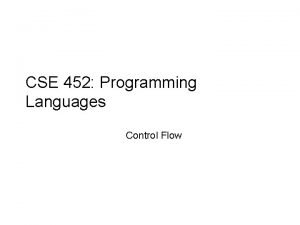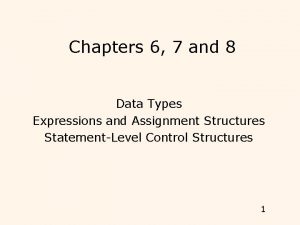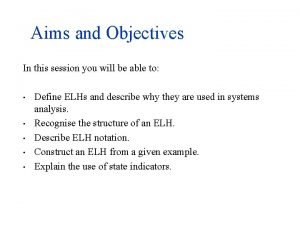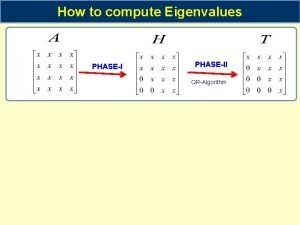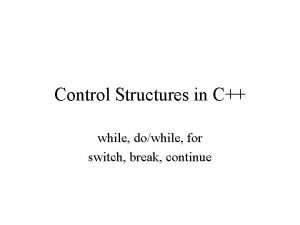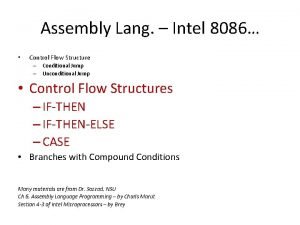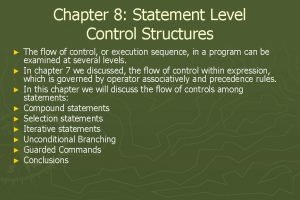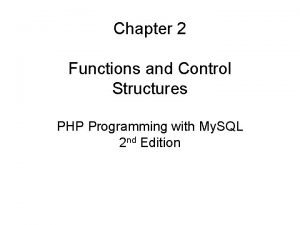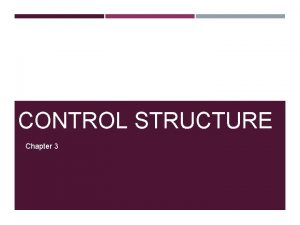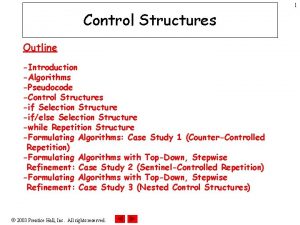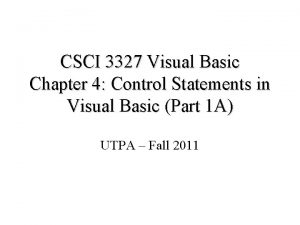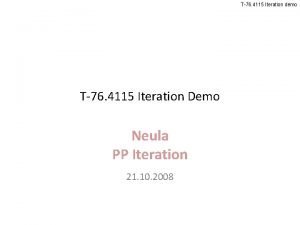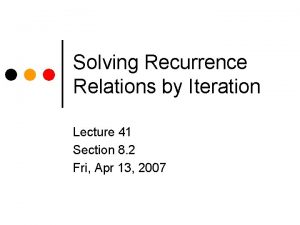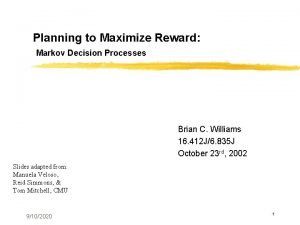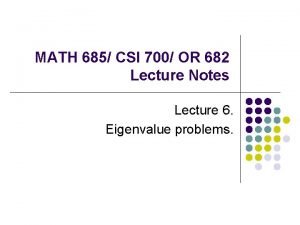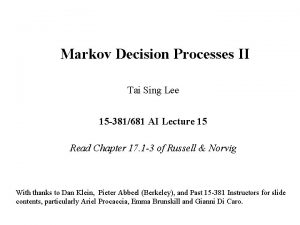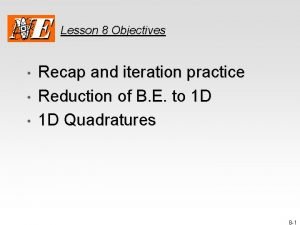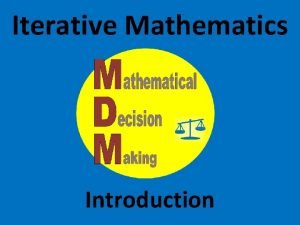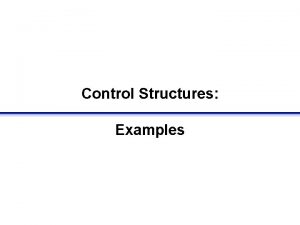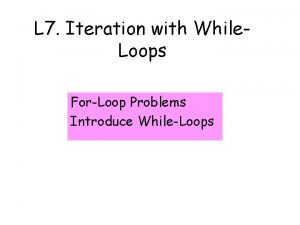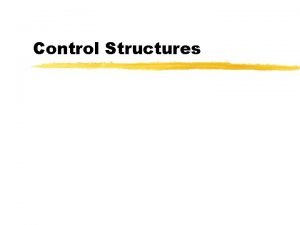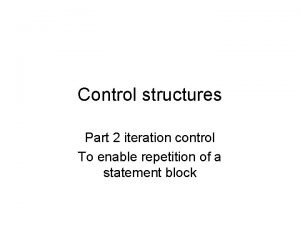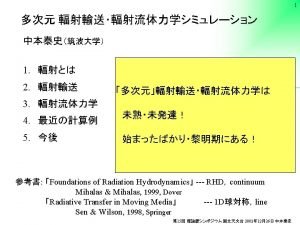Control Structures Examples forloop example First iteration k1






























- Slides: 30

Control Structures: Examples

for-loop example • First iteration (k=1, x=7) – test: 1<=3 is true – execute: x=7 -1=6 – update: k=2 for(k=a; k<=b; k++) • Second iteration (k=2, x=6) { – test: 2<=3 is true x=x-k; – execute: x=6 -2=4 } – update: k=3 • Third iteration (k=3, x=4) • A: x=1 – test: 3<=3 is true – execute: x=4 -3=1 – update: k=4 • Fourth iteration (k=4, x=1) – test: 4<=3 is false – exit loop • Q: If a=1, b=3, and x=7, what is the value of x when the loop terminates?

Another for-loop example • First iteration (k=2, x=1, y=9) – test: 2<4 is true – execute: x=1+2=3 y=9 -3=6 – update: k=3 for(k=a; k<b; k++) • Second iteration (k=3, x=3, y=6) { – test: 3<4 is true x=x+k; – execute: x=3+3=6 y=y-x; y=6 -6=0 } – update: k=4 • Third iteration (k=4, x=6, y=0) • A: x=6, y=0 – test: 4<3 is false – exit loop • Q: If a=2, b=4, x=1, and y=9, what are the values of x and y when the loop terminates?

while-loop example • First iteration (t=1, p=0) – test: 10>1 is true – execute: p=0+10*1=10 t=1+4=5 p=0; • Second iteration (t=5, p=10) t=1; – test: 10>5 is true n=10; – execute: p=10+10*5=60 while(n>t) t= 5+4=9 { • Third iteration (t=9, p=60) p=p+n*t; – test: 10>9 is true t=t+4; – execute: p=60+10*9=150 } t= 9+4=13 • Fourth iteration (t=13, p=150) • A: p=150 – test: 10>13 is false – exit loop • Q: What is the value of p when the loop terminates?

Another while-loop example • First iteration (n=-1, z=0, p=1) – test: 1<=10 is true – execute: z=-1*0*1=0 p= 1+4=5 n=-1 -3=-4 n=-1; z= 0; • Second iteration (n=-4, z=0, p=5) p= 1; – test: 5<=10 is true while(p<=10) – execute: z=-4*0*5=0 { p= 5+4=9 z=n*z*p; n=-4 -3=-7 p=p+4; • Third iteration (n=-7, z=0, p=9) n=n-3; – test: 9<=10 is true } – execute: z=-7*0*9=0 p= 9+4=13 n=-7 -3=-10 • A: z=0, p=13, n=-10 • Fourth iteration: exit loop • Q: What are the values of z, p, and n after executing the following statements?

Algorithm Design: Examples

Minimum of two integers Problem: Find the minimum of two integers

Minimum of two integers • Analyze the problem – Inputs • x first integer • y second integer – Output • minimum of x and y – How do we find the minimum? ? • if the first number is smaller than the second number, then the first number is the minimum • else, the second number is the minimum

Minimum of two integers • Design an algorithm to solve the problem 1. Get input values for x and y 2. Compute minimum value if(x < y) min = x; else min = y; 3. Return output value min

Sum of positive integers Problem: Find the sum of all positive integers less than or equal to some positive integer n

Sum of positive integers • Analyze the problem – Input • n a positive integer – Output • sum of all positive integers <=n – How to find the sum? ? • sum = 1+2+3+ … +n • initialize sum=0 • let k loop over the values [1, n] • compute sum=sum+k at each iteration of loop

Sum of positive integers • Design an algorithm to solve the problem 1. Get input value for n 2. Compute sum of integers 1 through n sum=0; for(k=1; k<=n; k++) { sum=sum+k; } 3. Return output value sum

Factorial Problem: Given some positive integer n, compute the factorial of n

Definition: factorial • The factorial of a positive integer n, denoted n!, is the product of the positive integers less than or equal to n • For example – 1! = 1 – 2! = 2*1 = 2 – 3! = 3*2*1 = 6 – 4! = 4*3*2*1 = 24 – 5! = 5*4*3*2*1 = 120 • We define the factorial of 0 to be 1 – 0! = 1

Factorial • Analyze the problem – Input • n a positive integer – Output • fn n!, the factorial of n – How to find the factorial? ? • fn = 1*2*3* … *n why don’t we • initialize fn=1 set fn=0? • let k loop over the values [2, n] • compute fn=fn*k at each iteration of loop

Factorial • Design an algorithm to solve the problem 1. Get input value for n 2. Compute product of integers 2 through n fn=1; for(k=2; k<=n; k++) { fn=fn*k; } 3. Return output value fn happens what when n=1?

Practice problems 1. Design an algorithm to compute the inclusive sum between two integers – example: for the input values 2 and 6, your algorithm should output 20 (because 2+3+4+5+6 = 20) 2. Design an algorithm that computes xn for an integer x and a non-negative integer n – xn is defined as follows: x 0 = 1 if n=0, otherwise xn = x*x*x* • • • *x n times

Practice problems 3. Design an algorithm to compute the maximum of two integers 4. Design an algorithm to compute the inclusive product between two integers – example: for the input values 3 and 6, your algorithm should output 360 (because 3*4*5*6 = 360)

Subroutines

Subroutines • Set of instructions to perform a particular computation – subproblems of more complex problems – repeated computation (e. g. different inputs) – may be used in solving other problems • Also called subprograms, methods, functions, procedures • Subroutines are named • Subroutines have zero or more parameters – list (possibly empty) of input values and their types • Subroutines have return types

A subroutine to add two integers int add(int x, int y) { return x+y; }

A subroutine to add two integers subroutine name parameters (input) return value int add(int x, int y) type (output) { return x+y; } return statement output value

Minimum of two integers - algorithm • • Problem: Find the minimum of two integers Algorithm: 1. Get input values for x and y 2. Compute minimum value if(x < y) min = x; else min = y; 3. Return output value min

Minimum of two integers - subroutine int minimum(int x, int y) { int min; variables used inside the subroutine must if(x < y) be declared min=x; else variables can min=y; not have the same name as return min; the subroutine }

Minimum of two integers v. 2 int minimum(int x, int y) { if(x < y) return x; else return y; }

Sum of positive integers - algorithm • Problem: Find the sum of all positive integers less than or equal to some positive integer n • Algorithm: 1. Get input value for n 2. Compute sum of integers 1 through n sum=0; for(k=1; k<=n; k++) { sum=sum+k; } 3. Return output value sum

Sum of positive integers - subroutine int sum_integers(int n) { int k; int sum=0; for(k=1; k<=n; k++) { sum=sum+k; } return sum; }

Factorial - algorithm • • Problem: Given some positive integer n, compute n! Algorithm: 1. Get input value for n 2. Compute product of integers 2 through n fn=1; for(k=2; k<=n; k++) { fn=fn*k; } 3. Return output value fn

Factorial - subroutine int factorial(int n) { int k; int fn=1; for(k=2; k<=n; k++) { fn=fn*k; } }

Practice problems • Write subroutines to perform the following computations: 1. Compute the inclusive sum between two integers n for an integer x and a non-negative 2. Compute x integer n 3. Compute the maximum of two integers 4. Compute the inclusive product between two integers
 Iteration control structures
Iteration control structures Iteration control structures
Iteration control structures Entity life history
Entity life history Human arm and whale flipper function
Human arm and whale flipper function Arnoldi iteration example
Arnoldi iteration example Positive control vs negative control operon
Positive control vs negative control operon Negative control vs positive control examples
Negative control vs positive control examples Hardware and control structures
Hardware and control structures Statement level control structures
Statement level control structures Intro.php?aid=
Intro.php?aid= Control structure in c
Control structure in c What are control structures in c++
What are control structures in c++ Types of control structures
Types of control structures Assembly language programming
Assembly language programming Statement level control structures
Statement level control structures Control structures in php
Control structures in php Control structure
Control structure Repetition pseudocode example
Repetition pseudocode example Visual basic control structures
Visual basic control structures Newton raphson method
Newton raphson method Iteration demo
Iteration demo Solve the recurrence relation
Solve the recurrence relation Iteration vs recursion
Iteration vs recursion Sequence, selection and iteration
Sequence, selection and iteration Value iteration
Value iteration Markov decision process
Markov decision process Orthogonal iteration
Orthogonal iteration Value iteration algorithm
Value iteration algorithm Tai sing lee
Tai sing lee What is the purpose of an iteration recap
What is the purpose of an iteration recap Iterative math
Iterative math
